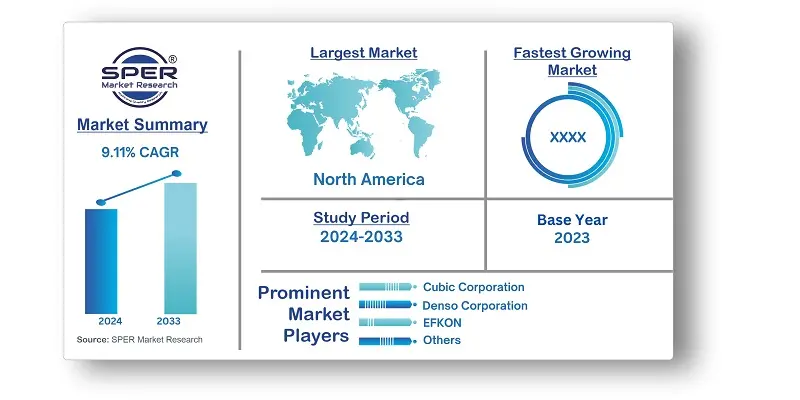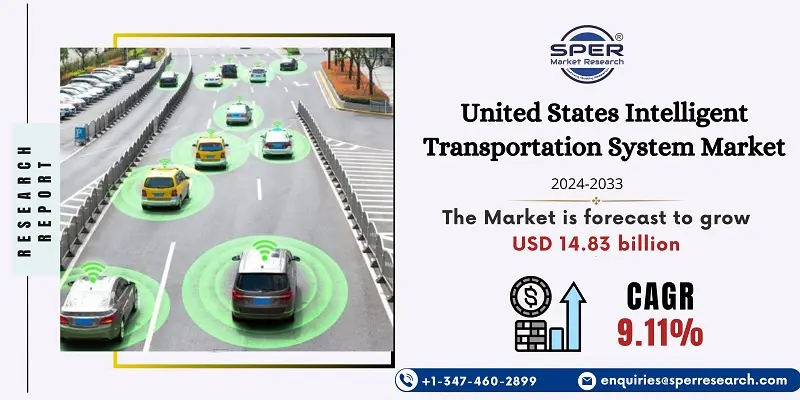
U.S. Intelligent Transportation System Market Growth, Size, Trends, Demand and Future Outlook
United States Intelligent Transportation System Market Size- By Mode of Transport, By Type, By Deployment Mode- Regional Outlook, Competitive Strategies and Segment Forecast to 2033
| Published: May-2024 | Report ID: AMIN24131 | Pages: 1 - 107 | Formats*: |
| Category : Automotive & Transportation | |||
- Siemens Intelligent Traffic Systems (ITS), a division of Siemens Mobility, announced the launch of its new brand Yunex Traffic in July 2021. Utilizing its dominant market position, innovative, astute, and all-encompassing mobility solutions will be provided.
- Plenary Infrastructure Group (Australia) awarded Kapsch TrafficCom the contract in June 2021 to implement a new toll collecting system on the Louisiana Highway (LA-1) for the Louisiana Department of Transportation and Development (LADOTD).


| Report Metric | Details |
| Market size available for years | 2020-2033 |
| Base year considered | 2023 |
| Forecast period | 2024-2033 |
| Segments covered | By Mode of Transport, By Type, By Deployment Mode |
| Regions covered | Eastern, Western, Northern, Southern |
| Companies Covered | Cubic Corporation, Denso Corporation, EFKON, FLIR Systems, Garmin, Kapsch TrafficCom, Q-Free, Siemens, Thales Group, Others |
- Automotive Manufacturers
- Government Agencies
- Infrastructure Developers
- Technology Providers
- Traffic Management Authorities
- Transportation Authorities
- Urban Planners
| By Mode of Transport: |
|
| By Type: |
|
| By Deployment Mode: |
|
- United States Intelligent Transportation System Market Size (FY’2024-FY’2033)
- Overview of United States Intelligent Transportation System Market
- Segmentation of United States Intelligent Transportation System Market By Mode of Transport (Roadways, Railway, Airways.)
- Segmentation of United States Intelligent Transportation System Market By Type {Advanced Traffic Management System (ATMS), Advanced Transportation Pricing System (ATPS), Advanced Traveler Information System (ATIS), Advanced Public Transportation System (APTS), Others}
- Segmentation of United States Intelligent Transportation System Market By Deployment Mode (On-Premise, Cloud)
- Expansion Analysis of United States Intelligent Transportation System Market
- Problems and Obstacles in United States Intelligent Transportation System Market
- Competitive Landscape in the United States Intelligent Transportation System Market
- Impact of COVID-19 and Demonetization on United States Intelligent Transportation System Market
- Details on Current Investment in United States Intelligent Transportation System Market
- Competitive Analysis of United States Intelligent Transportation System Market
- Prominent Players in the United States Intelligent Transportation System Market
- SWOT Analysis of United States Intelligent Transportation System Market
- United States Intelligent Transportation System Market Future Outlook and Projections (FY’2024-FY’2033)
- Recommendations from Analyst
1.1. Scope of the report1.2. Market segment analysis
2.1. Research data source
2.1.1. Secondary Data2.1.2. Primary Data2.1.3. SPER’s internal database2.1.4. Premium insight from KOL’s2.2. Market size estimation2.2.1. Top-down and Bottom-up approach
2.3. Data triangulation
4.1. Driver, Restraint, Opportunity and Challenges analysis4.1.1. Drivers4.1.2. Restraints4.1.3. Opportunities4.1.4. Challenges4.2. COVID-19 Impacts of the United States Intelligent Transportation System Market
5.1. SWOT Analysis
5.1.1. Strengths5.1.2. Weaknesses5.1.3. Opportunities5.1.4. Threats5.2. PESTEL Analysis5.2.1. Political Landscape5.2.2. Economic Landscape5.2.3. Social Landscape5.2.4. Technological Landscape5.2.5. Environmental Landscape5.2.6. Legal Landscape5.3. PORTER’s Five Forces5.3.1. Bargaining power of suppliers5.3.2. Bargaining power of buyers5.3.3. Threat of Substitute5.3.4. Threat of new entrant5.3.5. Competitive rivalry5.4. Heat Map Analysis
6.1. United States Intelligent Transportation System Market Manufacturing Base Distribution, Sales Area, Product Type6.2. Mergers & Acquisitions, Partnerships, Product Launch, and Collaboration in United States Intelligent Transportation System Market
7.1. United States Intelligent Transportation System Market Size, Share and Forecast, By Mode of Transport, 2020-20267.2. United States Intelligent Transportation System Market Size, Share and Forecast, By Mode of Transport, 2027-20337.3. Roadways7.4. Railway7.5. Airways
8.1. United States Intelligent Transportation System Market Size, Share and Forecast, By Type, 2020-20268.2. United States Intelligent Transportation System Market Size, Share and Forecast, By Type, 2027-20338.3. Advanced Traffic Management System (ATMS)8.4. Advanced Transportation Pricing System (ATPS)8.5. Advanced Traveler Information System (ATIS)8.6. Advanced Public Transportation System (APTS)8.7. Others
9.1. United States Intelligent Transportation System Market Size, Share and Forecast, By Deployment Mode, 2020-20269.2. United States Intelligent Transportation System Market Size, Share and Forecast, By Deployment Mode, 2027-20339.3. On-Premise9.4. Cloud
10.1. United States Intelligent Transportation System Market Size and Market Share
11.1. United States Intelligent Transportation System Market Size and Market Share By Region (2020-2026)11.2. United States Intelligent Transportation System Market Size and Market Share By Region (2027-2033)11.3. Eastern11.4. Western11.5. Northern11.6. Southern
12.1. Cubic Corporation12.1.1. Company details12.1.2. Financial outlook12.1.3. Product summary12.1.4. Recent developments12.2. Denso Corporation12.2.1. Company details12.2.2. Financial outlook12.2.3. Product summary12.2.4. Recent developments12.3. EFKON12.3.1. Company details12.3.2. Financial outlook12.3.3. Product summary12.3.4. Recent developments12.4. FLIR Systems12.4.1. Company details12.4.2. Financial outlook12.4.3. Product summary12.4.4. Recent developments12.5. Garmin12.5.1. Company details12.5.2. Financial outlook12.5.3. Product summary12.5.4. Recent developments12.6. Kapsch TrafficCom12.6.1. Company details12.6.2. Financial outlook12.6.3. Product summary12.6.4. Recent developments12.7. Q-Free12.7.1. Company details12.7.2. Financial outlook12.7.3. Product summary12.7.4. Recent developments12.8. Siemens12.8.1. Company details12.8.2. Financial outlook12.8.3. Product summary12.8.4. Recent developments12.9. Thales Group12.9.1. Company details12.9.2. Financial outlook12.9.3. Product summary12.9.4. Recent developments12.10. Others
SPER Market Research’s methodology uses great emphasis on primary research to ensure that the market intelligence insights are up to date, reliable and accurate. Primary interviews are done with players involved in each phase of a supply chain to analyze the market forecasting. The secondary research method is used to help you fully understand how the future markets and the spending patterns look likes.
The report is based on in-depth qualitative and quantitative analysis of the Product Market. The quantitative analysis involves the application of various projection and sampling techniques. The qualitative analysis involves primary interviews, surveys, and vendor briefings. The data gathered as a result of these processes are validated through experts opinion. Our research methodology entails an ideal mixture of primary and secondary initiatives.



Frequently Asked Questions About This Report
PLACE AN ORDER
Year End Discount
Sample Report
Pre-Purchase Inquiry
NEED CUSTOMIZATION?
Request CustomizationCALL OR EMAIL US
100% Secure Payment






Related Reports
Our Global Clients
Our data-driven insights have influenced the strategy of 200+ reputed companies across the globe.




















